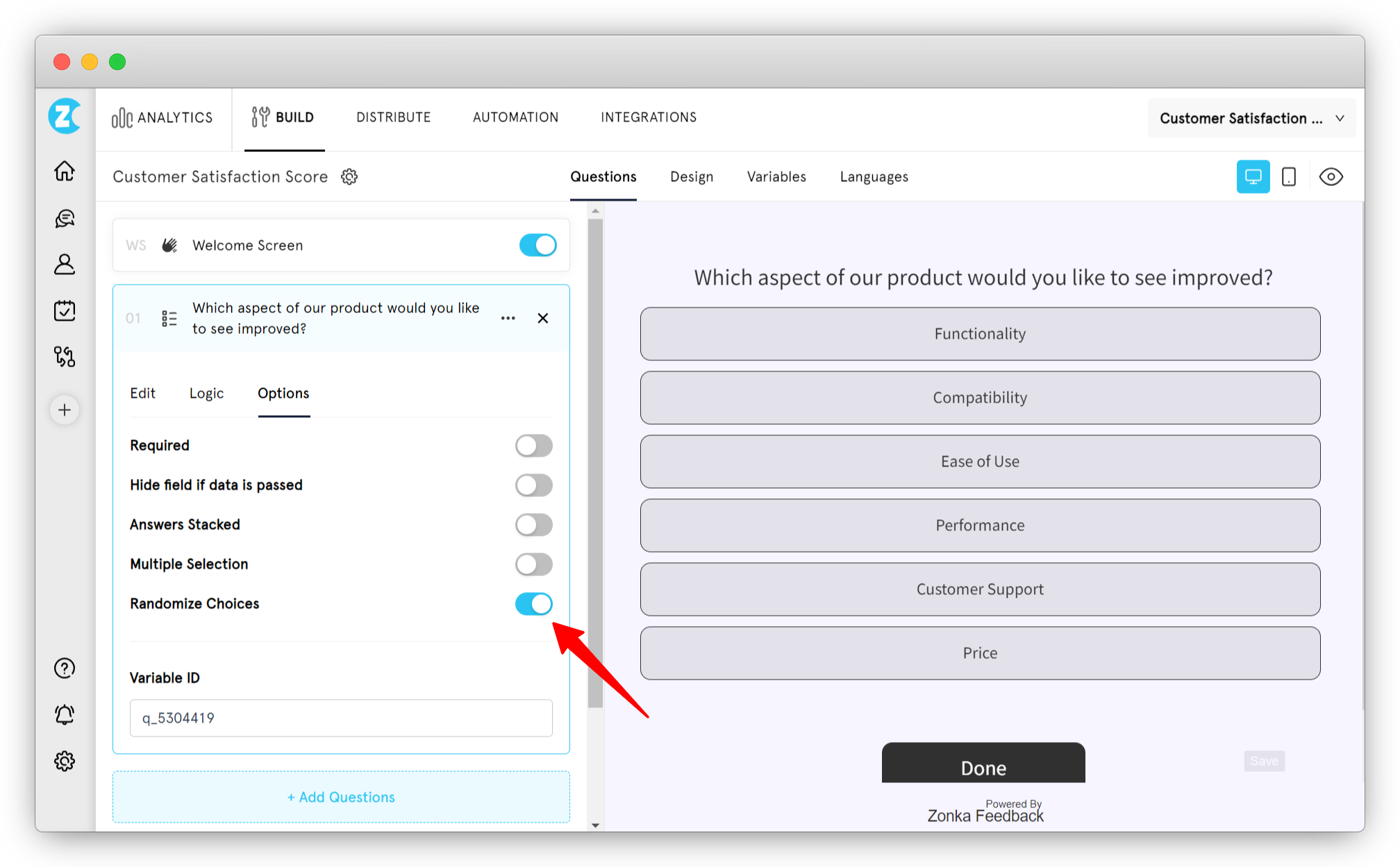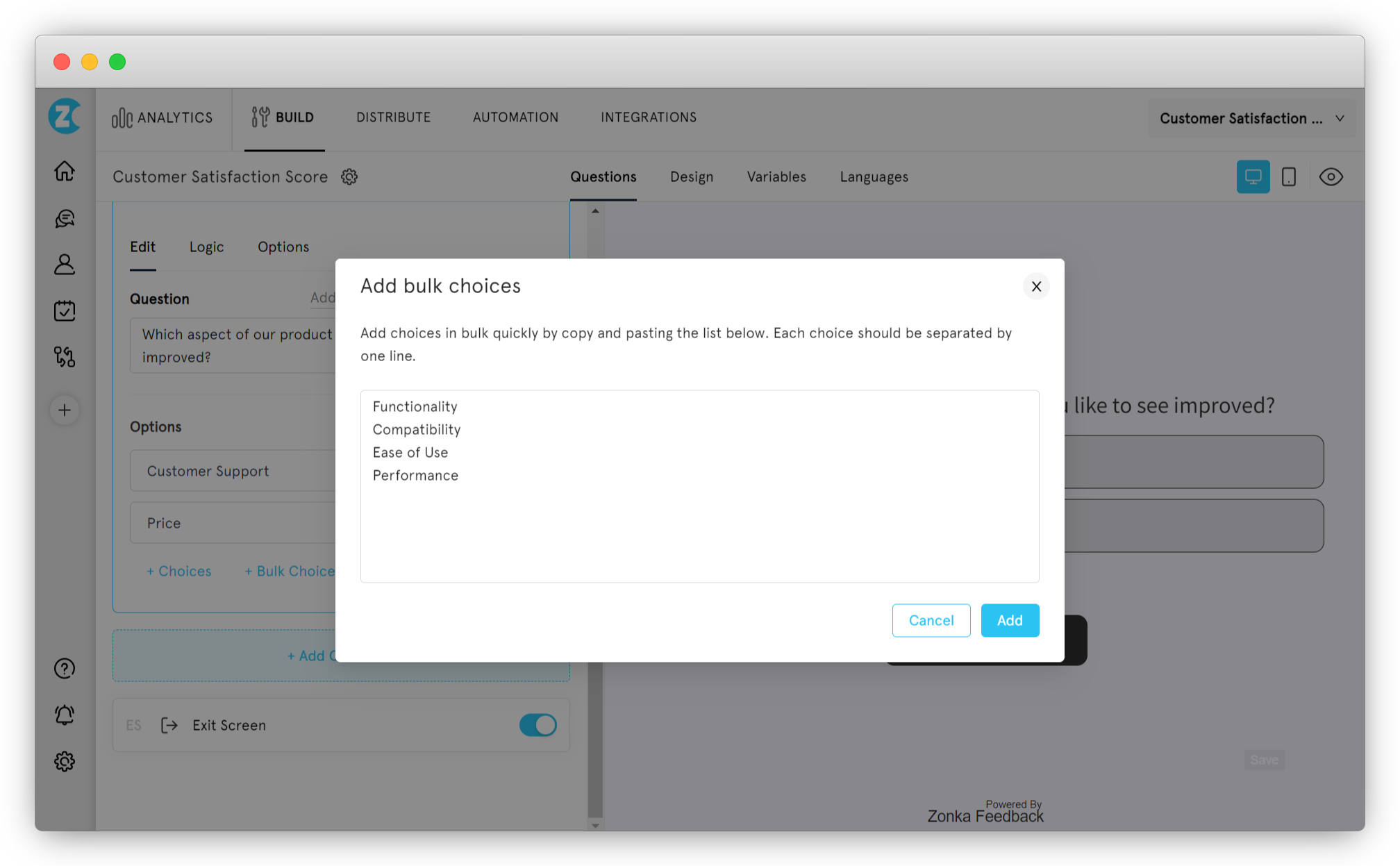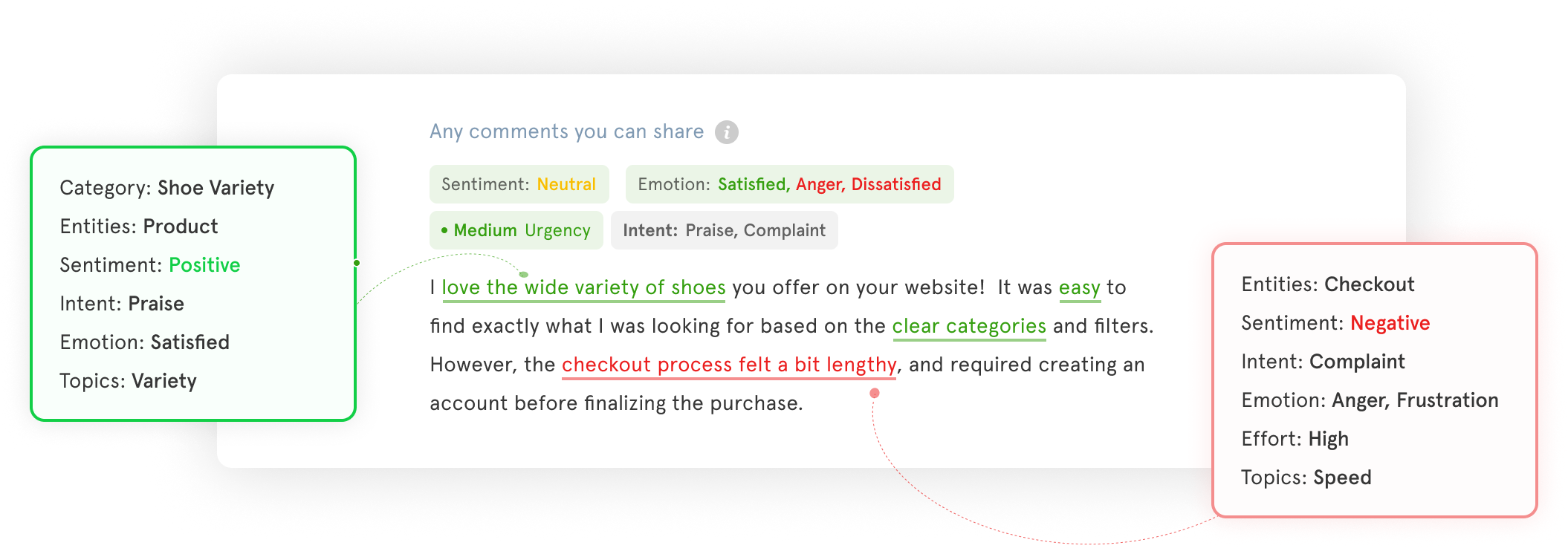Survey responses are invaluable for understanding customer sentiments and improving products or services. But sifting through endless survey responses to make sense of scattered feedback can be overwhelming. That's where multiple-choice questions come in.
Despite being often underestimated, these questions offer a structured and efficient way to gather insights. They are used in everything from gauging post-purchase satisfaction to understanding website usability to assessing employee training effectiveness, and even in political polling to gauge public opinion.
In this article, we will dive into the world of multiple-choice questions, uncovering their types, benefits, some use cases and real life examples, best practices, and how they can revolutionize the way you collect and analyze data. Let's get started!
TL;DR
-
Multiple choice questions are used in surveys, assessments, and exams, where one or more correct answer option is provided, and respondents have to select the right answer(s) from the list.
-
There are different types of multiple choice question types including single select answer choice, multiple selection, dropdown, checkbox, picture choice, and rating surveys among others.
-
They are used across industries including SaaS and technology, healthcare, eCommerce, and hospitality for collecting feedback on products, websites, employees, and more.
-
When used in conjunction with open-ended questions, multiple-choice questions can provide a holistic view of feedback responses, making it easier to analyze data across respondents.
-
Zonka Feedback offers you various types of multiple choice questions that can help you collect and measure feedback through different channels, and understand your customers better. Sign up for a free trial or book a demo to get started.
Collect Feedback with Multiple Choice Questions 🔥
Sign up for a free trial to measure customer satisfaction using various multiple choice questions.
What are Multiple Choice Questions?
Multiple choice questions (MCQs) are a type of closed ended question often used in surveys, assessments, and exams. In an MCQ, respondents are asked to select one or more answers from a list of choices. They are are popular because they are easy to answer, can cover a wide range of topics, and are simple to analyze.
According to industry benchmarks, multiple-choice questions typically have a response rate of around 60-70%, whereas open-ended questions may have a response rate of 30-40% or lower. This makes them most suitable for gathering quantitative data and for surveys where standardization of responses is important.
Commonly Used Multiple Choice Survey Question Types
Based on the number of answer choices that respondents can select or the type of selection that they get, multiple-choice questions can be of different types. Here are some commonly used MCQ-type questions that you can use in your surveys.
1. Single Answer Choice
Single answer choice is the classic format of MCQ type of questions in which respondents are presented with a list of answer choices, from which they can select only one answer after they eliminate incorrect answers. This type of MCQ question can be used for gathering information of factual questions on demographics, or knowledge-based quizzes and analyzing single-factor customer satisfaction surveys.

2. Multiple Selection
As the name suggests, multiple selection questions allows the test taker to choose multiple answers from a list of options. These are effective for gathering preferences with several possibilities (e.g., selecting all features used in software), identifying areas of expertise (e.g., programming languages known), or gauging customer satisfaction with multiple factors (e.g., gauging product satisfaction with respect to pricing, customer support, quality, features, etc.).

3. Drop Down
A dropdown in multiple-choice question format is an interactive element that provides a list of answer choices that respondents can reveal and select from by clicking on a down arrow. It is well suited for situations with a long list of options, especially when space is limited (e.g., selecting a location from a list of countries) or when order doesn't matter (e.g., choosing preferred contact method from email, phone, or social media).

4. Button Choice
Button choice questions present answer choices as clickable buttons which are a part of interactive features added to offer a visually appealing way to select options. It is ideal for situations where visual clarity or a limited number of answer choices are desired (e.g., selecting "Yes" or "No" for a binary question, or choosing a preferred product color from a set of buttons).

5. Checkbox
Similar to multiple selection, checkboxes allow respondents to choose multiple options from a list. It is effective for selecting multiple preferences with a clear visual representation (e.g., choosing desired product features from a list) or indicating areas of agreement with multiple statements presented as separate checkboxes.

6. Picture Choice
This MCQ format question incorporates images as answer choices, making it ideal for visual learners or when dealing with products or concepts that are better represented visually. It is perfect for situations where visual representation enhances clarity (e.g., selecting a preferred product design from image options) or for gathering preferences on visual elements (e.g., choosing the most appealing logo design).

7. Radio Buttons
A radio button multiple-choice question is a type of question where respondents can select only one option from a list of mutually exclusive choices. This means that once a respondent selects one option, selecting another will deselect the previous choice. Radio buttons are often represented by small circles or dots that can be filled in or selected. It is useful when you want to identify your standout product feature or the segment where your users would like to see some improvements.

8. Star Rating
Star rating is a quick and easy rating system that uses stars (often 5 star surveys) to gauge satisfaction, preference, or importance. It is ideal for gathering overall user experience ratings (e.g., rating satisfaction with a website or customer service interaction).

9. Smiley Rating MCQ
Similar to the star rating, smiley face surveys uses smileys (often ranging from happy to sad) to capture emotional responses or satisfaction levels. It is well-suited for gathering feedback in situations where a more emotional response is desired (e.g., gauging user satisfaction with a mobile game).

10. Likert Scale
This established scale presents statements and asks respondents to choose their level of agreement or disagreement using options like "Strongly Agree" to "Strongly Disagree" or "Very Satisfied" to "Very Dissatisfied." Likert scale surveys are ideal for measuring opinions or perceptions on a spectrum (e.g., gauging agreement with statements about a new company policy or various parameters of hospital treatment).

11. Ranking Scale
In ranking scale multiple-choice questions, your respondents can arrange the answer options based on their preference, allowing them to prioritize their choices by assigning a rank to each option. Ranking surveys are particularly useful when you want to understand the relative importance or preference of different features or items as in feature prioritization, service improvement, or product comparison.

12. CX Metric Questions
Incorporating CX metric questions into MCQ format allows you to quantitatively measure and track customer sentiment, satisfaction, and effort, providing actionable insights for improving the overall customer experience. They can be of these types:
- NPS: It measures customer loyalty and you can use them to evaluate the percentage of the net promoters and detractors for your brand.
- CSAT: It is ideal to use in your survey when you want to see how happy your clients are with an action your business took or certain aspects of your products/services.
- CES: CES surveys are designed to measure the ease of a customer's experience when interacting with your product or service.
 13. Yes/No Question
13. Yes/No Question
An extremely popular question format, Yes or no surveys have multiple choice questions presents the respondents with a statement and two answer choices: yes or no. They are a simple and quick way to gather information and are widely used in customer satisfaction surveys for gathering factual information on checkout process, website usability, product features, customer service interaction among others.
 14. 7-Scale Rating
14. 7-Scale Rating
The 7-scale rating is an effective way to assess the intensity or magnitude of an experience or opinion. Respondents rate statements or questions on a scale of 1 to 7, indicating their level of agreement, satisfaction, or importance. You can use 7-star rating scale or numbered 1 to 7 satisfaction scale or even employ 7 emoji surveys to capture feedback. They are used across all types of surveys including market research, customer satisfaction, and product feedback.

15. Thumbs Up/Down
This simple format of thumbs up/down rating scale provides a binary option for positive or negative feedback using thumbs-up/down icons. It is effective for gauging quick reactions or overall sentiment (e.g., liking or disliking a social media post) or gathering content feedback in content experience surveys.
Why are MCQ Important: Reasons & Benefits
Multiple choice questions sure are the quickest and easiest way to gather responses. But that's not the only reason to use them. Let us look at some reasons and advantages they offer due to which you must consider them in your surveys.
-
Standardized Data: MCQs provide pre-defined answer choices, resulting in consistent and easily analyzed data. This simplifies the process of summarizing responses and drawing conclusions from survey responses.
-
Faster Data Collection: Compared to open-ended questions that allow respondents to express their thoughts in their own words which can be time-consuming, MCQs are a faster way to collect data as they allow test takers to select their answers quickly, leading to shorter survey completion times.
-
Reduced Ambiguity: Multiple-choice questions minimize the chances of misinterpretation or irrelevant answers as respondents choose from pre-defined options, eliminating the need to interpret survey responses that may vary in clarity or relevance as in the case of open-ended questions. This reduces ambiguity for both respondents and analysts, leading to more accurate and actionable data.
-
Data Comparison: Multiple-choice questions enable easy comparison of responses across different demographics or groups within your survey population, allowing for deeper insights into preferences, opinions, and trends.
-
Offers Guidance to Respondents: MCQ questions can act as guidance for respondents by providing structured choices that help them navigate the survey or assessment. The clear and concise options in MCQs can direct respondents towards relevant answers, especially when the questions are well-designed to cover all possible responses.
-
Engaging for Respondents: Multiple-choice questions can be engaging due to their interactive nature, offering respondents to choose the most appropriate answer from a variety of options to choose from. This can increase response rates as it allows respondents to quickly and easily participate in satisfaction surveys.
However, it's important to note that MCQs might not be ideal for every situation. For example, when conducting a customer satisfaction survey, MCQs can provide insights into overall satisfaction levels but open-ended questions may be more suitable for understanding the reasons behind a customer's rating.
💡You should always consider including open-ended questions alongside MCQs to get a comprehensive understanding of feedback responses in certain cases.
When to Use Multiple Choice Questions?
Multiple choice questions are versatile in nature and can be used in various situations to gather feedback. Here are some specific scenarios where you can use them to collect feedback.
-
At Specific Event
Multiple choice questions can be used to collect feedback at specific events, such as after website redesign, training sessions, user onboarding, or any new feature launch. For example, an event organizer may use MCQs to assess attendees' satisfaction with the event's content, speakers, and logistics.
-
Throughout the Customer Journey
As customers interact with your product or service at different touchpoints, MCQs, when strategically placed can reveal pain points and areas for improvement throughout their journey. For example, you can use MCQs to gather feedback on the purchase process, delivery experience, and post delivery support.
-
Post Interaction/Transaction
Multiple choice questions are effective for measuring satisfaction after an interaction or transaction to gather instant feedback and improve processes. For example, you can use MCQs after customers places an order, after customer support chat, post meeting feedback, or after product demo to gauge customer satisfaction.
-
As Follow up
Multiple choice answer options can also be used as a follow-up to previous feedback or interactions. For example, a customer service team may use MCQs in a follow-up survey to gather feedback on the resolution of a customer complaint or the effectiveness of a support interaction.
Real-Life Multiple Choice Questions Examples & Use Cases Based on Industries
Multiple choice questions are highly versatile tools used across industries for various purposes. They assess knowledge, gather feedback, and personalize experiences. Whether in education to promote engagement and assess student understanding or in healthcare to streamline patient intake, MCQ questions are valuable for informed decision-making and enhanced customer experiences.
Here are some industry-specific use cases and real-life examples of MCQ surveys, along with a cheat sheet of questions and templates to help you get started.
1. SaaS and Technology
In SaaS and technology, multiple choice questions can be used to gather feedback on specific features or aspects of your SaaS product. You can also use them after new feature rollout or collect bug report, feature prioritization and new user onboarding.
Here are some examples of multiple choice questions you can ask while measuring satisfaction:
-
How satisfied are you with the latest feature update?
-
Very satisfied
-
Satisfied
-
Neutral
-
Dissatisfied
-
Very dissatisfied
-
- Have you encountered any bugs or issues while using our software?
-
-
Yes, frequently
-
Yes, occasionally
-
No, never
-
- How would you rate the onboarding process for new users?
-
-
Very easy
-
Easy
-
Neutral
-
Difficult
-
Very difficult
-
- How satisfied are you with our SaaS product overall?
-
-
Very satisfied
-
Satisfied
-
Neutral
-
Dissatisfied
-
Very dissatisfied
-

Real-life Example: SmartQ
SmartQ, a SaaS and Technology company, used Zonka Feedback's on-premise platform to manage digital customer feedback effectively. They implemented various survey question types, including multiple choice questions, to measure satisfaction and gather insights for service enhancement. This structured feedback approach enabled SmartQ to analyze data and make informed decisions to improve their offerings and customer experience.
2. eCommerce
In eCommerce, multiple choice questions are instrumental in refining product discovery and navigation based on user searches. They also enable personalized product recommendations, measure post-purchase satisfaction, and collect valuable product reviews to enhance the overall shopper experience.
Here are some e-commerce survey questions examples of multiple choice questions you can ask:
- How easy was it to find the product you were looking for?
-
-
Very easy
-
Easy
-
Neutral
-
Difficult
-
Very difficult
-
-
How satisfied are you with your shopping experience overall?
-
Very satisfied
-
Satisfied
-
Neutral
-
Dissatisfied
-
Very dissatisfied
-
-
Would you recommend this product to others?
-
Yes
-
No
-
Maybe
-
-
How would you rate your overall experience on our website?
-
Excellent
-
Good
-
Average
-
Poor
-
Very poor
-
Real-life Example: Damas
Damas wanted to enhance in-store shopping experiences across 163 stores but lacked insight into post-transaction customer interactions.
Using Zonka Feedback's surveys with various question types like multiple choice, rating scale, and NPS questions, Damas assessed customer satisfaction and loyalty across all store locations. They also utilized email and offline surveys to collect personalized feedback and gain real-time insights into the customer experience.
3. Healthcare
In healthcare, multiple choice questions can be used for streamlining patient intake and screenings, enhancing patient education and self-care, facilitating shared decision-making, gathering feedback for improved patient satisfaction, and collecting data for research purposes to advance medical knowledge.
Here are some health survey questions examples of multiple choice questions you can consider:
-
How confident are you in managing your condition after receiving education from our healthcare team?
-
Very confident
-
Confident
-
Neutral
-
Not very confident
-
Not confident at all
-
-
How involved do you feel in decisions about your treatment plan?
-
Very involved
-
Somewhat involved
-
Neutral
-
Not very involved
-
Not involved at all
-
-
How satisfied are you with the care you received?
-
Very satisfied
-
Satisfied
-
Neutral
-
Dissatisfied
-
Very dissatisfied
-
-
Are you willing to participate in future research studies to help advance medical knowledge?
-
Yes, definitely
-
Yes, probably
-
Not sure
-
Probably not
-
Definitely not
-
Real-life Example: Sankara Eye Hospital
Sankara Eye Hospital sought to efficiently manage the high volume of patient feedback. They implemented Zonka Feedback's robust feedback management, utilizing surveys with multiple choice, NPS, and CSAT questions. With accessibility across all 13 hospital locations, Zonka Feedback provided a centralized system for convenient data storage, review, and analysis, ultimately enhancing their patient experience.
4. Hospitality
In the hospitality industry, multiple choice questions play a crucial role in enhancing the guest experience. They can be utilized at various touchpoints throughout the guest journey, including pre-arrival booking, room service ordering, in-stay experience enhancement, post-stay feedback collection, and continuous improvement efforts.
Here are some examples of multiple choice questions you can ask in hospitality industry:
-
How did you find out about our hotel?
-
Online search
-
Social media
-
Referral
-
Other (please specify)
-
-
How would you rate the speed of our room service?
-
Very fast
-
Fast
-
Average
-
Slow
-
Very slow
-
-
How likely are you to recommend our hotel to others?
-
Very likely
-
Likely
-
Neutral
-
Unlikely
-
Very unlikely
-
-
What is one thing we could do to improve your next stay?
-
Provide more amenities
-
Improve customer service
-
Enhance room quality
-
Other (please specify)
-
Real-life Example: Mozaic
Mozaic implemented Zonka Feedback's omnichannel system to manage a large volume of guest feedback efficiently. They utilized multiple choice questions, rating scales, and CSAT questions to collect feedback at key touchpoints. Additionally, Mozaic set up negative feedback SMS alerts to promptly address customer concerns and maintain high satisfaction levels.
5. Education
In education, multiple choice questions can be used for assessments and knowledge checks in formative and standardized tests. Additionally, they enhance learning and engagement through interactive quizzes, promote discussion and critical thinking, and gather valuable feedback from students on course content, teaching style, and classroom environment.
Here are some examples of multiple choice questions you can ask in education sector:
-
How would you rate the effectiveness of the instructor's teaching methods?
-
Very effective
-
Effective
-
Neutral
-
Ineffective
-
Very ineffective
-
-
How would you rate the classroom environment for promoting learning?
-
Excellent
-
Good
-
Fair
-
Poor
-
Very poor
-
-
Which is the largest planet in our solar system?
-
Mars
-
Jupiter
-
Saturn
-
Earth
-
-
How would you rate the usefulness of the course materials (e.g., textbooks, readings, online resources)?
-
Very useful
-
Useful
-
Neutral
-
Not very useful
-
Not useful at all
-
Real-life Example: Queensland University of Technology
Queensland University of Technology (QUT) utilized Zonka Feedback's iPad software to gather valuable feedback from students, faculty, and clients at various touchpoints and events. By implementing multiple choice questions, QUT was able to assess satisfaction levels and gather specific insights to improve their services and offerings based on the feedback received.
6. Retail
In retail, MCQs go beyond online interactions. They can be used in-store to understand customer demographics and buying intent through entrance/exit surveys or product display embedded questions. Additionally, MCQs on kiosks personalize product recommendations and gather feedback on service interactions, while loyalty program sign-up MCQs inform targeted promotions and inventory management.
Here are some examples of retail survey questions in multiple choice format that you can ask in your survey:
-
How did you hear about our store?
-
Online search
-
Social media
-
Referral
-
Other (please specify)
-
-
Which product display caught your attention the most?
-
Display A
-
Display B
-
Display C
-
None
-
-
How would you rate the friendliness of our staff?
-
Very friendly
-
Friendly
-
Neutral
-
Unfriendly
-
Very unfriendly
-
-
Are you interested in joining our loyalty program?
-
Yes, definitely
-
Yes, maybe
-
No, not interested
-
Real-life Example: Leroy Merlin
Leroy Merlin optimized their feedback collection process with post-purchase surveys using Zonka Feedback. By deploying SMS surveys across 95 locations, they amassed over 15,000 responses monthly. The incorporation of multiple choice questions helped them gain quick insights and enhance their customer experience significantly.
7. Fintech
In fintech, multiple choice questions can help to personalize financial products and services, educate users, and offer efficient customer support. They help tailor offerings to meet user needs, improve financial literacy, streamline interactions, and drive continuous improvement in the user experience.
Here are some examples of multiple choice questions you can ask in fintech industry:
-
How would you rate your knowledge of investing?
-
Expert
-
Intermediate
-
Beginner
-
No knowledge
-
-
How satisfied are you with the response time of our customer support team?
-
Very satisfied
-
Satisfied
-
Neutral
-
Dissatisfied
-
Very dissatisfied
-
-
How likely are you to recommend our financial app to a friend or colleague?
-
Very likely
-
Likely
-
Neutral
-
Unlikely
-
Very unlikely
-
-
Which new feature would you most like to see in our app?
-
Budgeting tools
-
Investment tracking
-
Bill payment reminders
-
Credit score monitoring
-
Other (please specify)
-
Real-life Example: Simpl
Seeking to enhance its feedback mechanism and streamline its pre-implementation experience management, Simpl required a customizable survey tool to design surveys with various question types, including multiple choice, 1 to 5 rating, NPS, and CSAT surveys. Opting for Zonka Feedback due to its user-friendly platform, Simpl successfully gathered feedback via email and SMS from its extensive user base of nearly 600,000 users. This enabled them to reimagine services, make informed decisions, and prioritize customer needs effectively.
Examples of Multiple Choice Questions to Collect Different Types of Feedback
Measuring customer satisfaction and continuously improving on them is what distinguishes your business from other options. Whether your customers are dining in at a restaurant, making a purchase at your store, or exploring your product, the use of multiple-choice question surveys can help gather actionable feedback. These surveys can also be implemented at airports, post-flight experiences, hotel stays, and many other situations to gauge customer satisfaction and improve services.
a. Customer Experience & Satisfaction
Multiple choice questions are extremely helpful in gauging customer experience and satisfaction. You can ask question related to the ease of navigating your app to assess user experience, product quality, delivery times, or customer service interactions. You can also delve into specific aspects of customer experience, such as pricing, packaging, or return policies, to provide detailed insights for improvement.
-
How would you rate the timeliness of our product/service delivery?
-
Very timely
-
Timely
-
Neutral
-
Delayed
-
Very delayed
-
-
How satisfied are you with the assistance provided by our customer service team?
-
Very satisfied
-
Satisfied
-
Neutral
-
Dissatisfied
-
Very dissatisfied
-
-
How would you rate your overall experience with our company?
-
Excellent
-
Good
-
Average
-
Poor
-
Very poor
-

b. Website Feedback
To get website feedback, you can use multiple-choice questions that gauge user experience, satisfaction with the website layout and design, ease of navigation, and overall impression. These questions can help you understand how visitors perceive your website and identify areas for improvement to enhance their browsing experience.
-
How would you rate your overall experience on our website?
-
Excellent
-
Good
-
Average
-
Poor
-
Very poor
-
-
How visually appealing do you find our website?
-
Very appealing
-
Appealing
-
Neutral
-
Not very appealing
-
Not appealing at all
-
-
Did the content on our website meet your needs?
-
Yes, completely
-
Yes, to some extent
-
No, not really
-
-
How satisfied are you with the load time of our website pages?
-
Very satisfied
-
Satisfied
-
Neutral
-
Dissatisfied
-
Very dissatisfied
-

c. Employee Feedback
To get employee feedback, you can use multiple choice questions to ask questions on various aspects of their job satisfaction, engagement, and overall experience at the company. These questions can cover areas such as job satisfaction, work-life balance, communication with managers, training and development opportunities, and overall satisfaction with the company culture.
-
How satisfied are you with your current role?
-
Very satisfied
-
Satisfied
-
Neutral
-
Dissatisfied
-
Very dissatisfied
-
-
How would you rate your work-life balance at our company?
-
Excellent
-
Good
-
Average
-
Poor
-
Very poor
-
-
How would you rate the communication between employees and managers?
-
Excellent
-
Good
-
Average
-
Poor
-
Very poor
-
-
How satisfied are you with the training and development opportunities provided by the company?
-
Very satisfied
-
Satisfied
-
Neutral
-
Dissatisfied
-
Very dissatisfied
-
-
How engaged do you feel in your work?
-
Very engaged
-
Engaged
-
Neutral
-
Disengaged
-
Very disengaged
-

d. Spa & Gym Experience
Multiple choice questions can help measure spa and gym experiences by assessing service satisfaction, facility cleanliness, staff interactions, and overall satisfaction. Questions about recommendations and likelihood of future visits can further indicate customer loyalty and provide insights for improvement.
-
How clean did you find the spa/gym facilities?
-
Very clean
-
Clean
-
Average
-
Not very clean
-
Very dirty
-
-
Were the staff members friendly and helpful during your visit?
-
Yes, very friendly and helpful
-
Yes, somewhat friendly and helpful
-
No, not very friendly or helpful
-
-
How would you rate your overall experience at the spa/gym?
-
Excellent
-
Good
-
Average
-
Poor
-
Very poor
-
-
Would you recommend our spa/gym to a friend?
-
Yes, definitely
-
Yes, maybe
-
No, probably not
-
No, definitely not
-

e. Facilities Feedback
Multiple choice questions can help measure facility feedback by providing a structured way for customers to express their opinions. For example, businesses like malls, stores, airports, and offices can use multiple choice questions in surveys to collect feedback on facilities. This approach offers a quick and easy way to gather feedback on areas such as washrooms, cafeterias, receptions, and more.
-
How would you rate the cleanliness of our facilities?
-
Very clean
-
Clean
-
Average
-
Not very clean
-
Very dirty
-
-
How comfortable did you find our facilities?
-
Very comfortable
-
Comfortable
-
Neutral
-
Uncomfortable
-
Very uncomfortable
-
-
How satisfied are you with the amenities provided in our facilities?
-
Very satisfied
-
Satisfied
-
Neutral
-
Dissatisfied
-
Very dissatisfied
-
f. Customer Service Feedback
Multiple choice questions are highly effective for collecting customer service feedback, especially after interactions such as post-ticket resolution, agent interactions, and general service experiences. Integrating customer service surveys in MCQ format with helpdesk, service desk, or chat platforms enables you to trigger surveys seamlessly, automating email surveys after ticket closures, or including in-signature surveys in agent replies.
This approach provides a quick and structured way for customers to share their feedback, allowing you to gather valuable insights for improving your customer service.
-
How satisfied are you with the resolution of your recent support ticket?
-
Very satisfied
-
Satisfied
-
Neutral
-
Dissatisfied
-
Very dissatisfied
-
-
How would you rate the helpfulness of the agent you interacted with?
-
Very helpful
-
Helpful
-
Neutral
-
Unhelpful
-
Very unhelpful
-
-
How satisfied are you with the assistance provided during the chat session?
-
Very satisfied
-
Satisfied
-
Neutral
-
Dissatisfied
-
Very dissatisfied
-

g. Passenger Experience
Multiple choice questions can help collect passenger feedback at the airports efficiently. Feedback kiosks and post-flight surveys sent via email to passengers can be extremely effective to collect passenger feedback. The multiple-choice questions in your surveys can cover experiences at boarding gates, check-in counters, security, lounges, and washrooms.
-
How would you rate the boarding process at the gate?
-
Excellent
-
Good
-
Average
-
Poor
-
Very poor
-
-
How would you rate the efficiency of the security screening process?
-
Very efficient
-
Efficient
-
Neutral
-
Inefficient
-
Very inefficient
-
-
How satisfied were you with the airport lounge facilities?
-
Very satisfied
-
Satisfied
-
Neutral
-
Dissatisfied
-
Very dissatisfied
-
-
How would you rate the cleanliness of the airport washrooms?
-
Very clean
-
Clean
-
Average
-
Not very clean
-
Very dirty
-

Best Practices & Tips to Collect Feedback through Multiple Choice Questions
Let us look at some of the best practices and tips that you can implement while using multiple choice questions to get feedback from your target audience.
1. Choosing the Right MCQ Type
By choosing the right MCQ type based on the context of your survey questions, you can ensure that respondents can easily provide accurate feedback, leading to more valuable insights for your organization. For example, use single answer choice when you want a clear-cut and definitive answer, picture choice when you want to make the survey more engaging and bypasses language limitations, and drop-down when there is a long list of options or to conserve space.
2. Randomize Answer Order
Randomizing answer order helps prevent order bias, where the answer position influences someone's choice. By shuffling options, each answer has an equal chance of being selected, leading to more accurate and unbiased data. It also encourages respondents to read all options carefully for more thoughtful feedback.

3. Offering Bulk Choices
Bulk choices allow survey creators to easily add multiple options at once, rather than adding them one by one. This saves time and effort, especially when creating surveys with a large number of choices. With bulk choices, you can quickly populate surveys with all the necessary options, ensuring that respondents have the flexibility to select multiple choices as needed. Therefore opt for a survey tool that offers this feature to streamline your survey creation process.

4. Positioning MCQ Options
The position of answer choices in MCQs can subtly influence respondents, making it a detail worth considering when crafting effective surveys. You should choose to align the positioning of your survey in these:
Vertical Answer Stacking: It encourages a more linear thought process when considering each option and is easier to follow the flow of the question and answer choices, especially for longer questions or answer sets.
Horizontal Answer Stacking: It can be more space-saving when dealing with a large number of answer choices and helps to a more even distribution of responses, as all options are visually presented at the same level.
5. Including an 'Other' Option
Including an 'other' option in multiple choice questions allows your respondents to provide answers that are not listed in the predefined options. Using this option welcomes any additional, less common, or unexpected responses that respondents may want to provide, ensuring that the survey is comprehensive and inclusive of all possible answers.
6. Leveraging Open-ended Question Feedback
Adding open-ended questions alongside multiple-choice questions allows respondents to provide detailed explanations or additional insights that may not be captured by the predefined options. This can lead to richer qualitative data, providing deeper insights into respondent opinions and experiences. You should choose a survey software that offers:
- Text Analysis: It can categorize responses into themes or topics, helping to identify key themes, sentiments, and trends within open-ended responses, providing deeper insights into customer opinions and experiences without manually reviewing every feedback.
- Sentiment Analysis: It can determine the overall sentiment of the structured and unstructured data by allowing respondents to express their thoughts freely. With Zonka Feedback's sentiment analysis tool, your responses can be automatically categorized as positive, negative, or neutral providing insights into customer feelings.

7. Taking Action to Close Feedback Loop
Once you have the required data from survey responses in multiple choice questions, you need to take action on the data and to improve customer satisfaction and business operations.
- Setting Automated Alerts and Responses: With this, you can never miss a critical customer concern. Set up automated alerts and responses based on specific keywords, sentiment analysis, or low satisfaction ratings, ensuring timely responses to pressing issues.
- Collaborating with Teams: Direct the negative feedback responses to the concerned team to facilitate collaboration and ensure accountability for addressing customer concerns.
- Organizing Responses with Auto Tagging: No more sifting through mountains of data. With this, you can automatically tag responses based on keywords or sentiment, allowing for efficient organization and retrieval of specific feedback.
- Streamlined Response Inbox: Manage all your customer feedback in one centralized location. Zonka Feedback provides a user-friendly response inbox for easy access, prioritization, and response management.
- Follow Up: Simplify follow up communication with drafts and send personalized responses directly within the platform, demonstrating to customers that their feedback is valued and acted upon to close the feedback loop.
Using Multiple Choice Questions with Zonka Feedback
With Zonka Feedback, you can create and use multiple choice questions in your surveys to collect customer feedback and satisfaction. Here a few simple steps to get started:
-
Create your free account for the customer experience software
-
Choose whether you would like to use AI to create your survey, or select from range of survey templates. You can also start from scratch if you like
-
Select your distribution channel among email, website, SMS, In-app, offline, survey links or live chat to get instant feedback
-
Customize your survey as you like with the type of multiple choice questions, language, design, themes and more
-
Set up automation and workflows based on feedback data
-
View real-time reports and analysis
-
Close the feedback loop
Benefits of Using Zonka Feedback as your MCQ Survey Tool
If you are wondering why you should choose Zonka Feedback to create your multiple choice question surveys, here are some compelling reasons for you consider:
-
Easy to Set up with No Technical Expertise Required
Using Zonka Feedback to create multiple choice questions survey doesn't require any technical know how. You can easily use the interface to create engaging surveys for different CX metrics or other surveys like product feedback, employee feedback and more.
-
Omnichannel Experience Management Platform
You can easily share your MCQ survey questions wherever your customers are most active - be it website, SMS, in-app, in-product, email, on-premises using the survey apps, offline surveys and kiosk surveys to capture valuable feedback.
-
AI Features for Automation & Analysis
The AI features like automatic alerts and responses based on customer behavior and triggers, workflow management for team members, natural language processing (NLP) for sentiment analysis and text categorization, machine learning algorithms for trend analysis and AI driven insights for actionable improvements make this survey tool highly effective while analysing multiple choice question responses.
-
Powerful Data Security
Zonka Feedback ensures data security through encryption, access control, regular data backup, compliance with regulations like GDPR, and hosting on secure infrastructure. This makes your customer experience management safeguarded against data breaches and unauthorized access.
-
Real-Time Feedback Reports
You can collect real-time insights with snapshot report, trends report, graphical survey reporting and more so that you have all the information you need to make informed decisions and improve your customer experience.
-
Easy Integration with your Favorite Tools
You can seamlessly integrate Zonka Feedback with existing software tools such as Salesforce, Intercom, HubSpot, Google Analytics and more using native integrations or build your own integrations using APIs. This allows you to streamline your workflow and centralize your customer feedback data, ensuring you can leverage the full potential of your existing tools to enhance your customer experience.
Conclusion
Multiple choice questions offer a versatile and efficient way to assess knowledge, gather feedback, and engage audiences across various industries. By designing thoughtful and well-structured multiple-choice questions, you can gain valuable insights, streamline decision-making processes, and enhance customer experiences.
Whether used in education, healthcare, hospitality, or other sectors, these questions serve as powerful tools for data collection and analysis, ultimately driving improved outcomes and informed decision-making.
By using an effective online survey software like Zonka Feedback, you can create surveys with multiple choice questions using predefined survey templates, distribute them with multiple channels, analyze responses using sentiment analysis and advanced analytics, and take action to close the feedback loop.
Sign up for a free account and start creating multiple choice questions to collect feedback efficiently!

 MS Teams
MS Teams


















